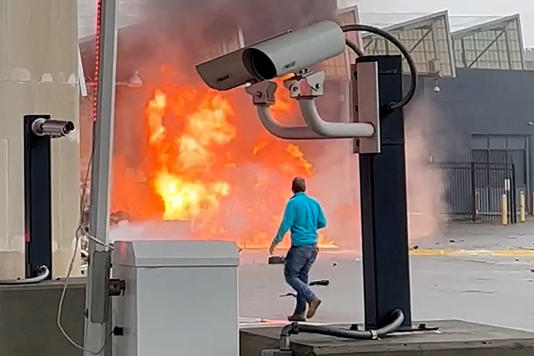
Following this week’s crash on the Rainbow Bridge — which closed Niagara border crossings and prompted questions about public safety — Niagara Region’s police chief is warning the community about the spread of misinformation.
“We saw an immense amount of misinformation and speculation on both mainstream and social media platforms, which created significant and unnecessary anxiety in the community,” said Niagara police chief Bryan MacCulloch.
MacCulloch made his comments to the Niagara Region Police Services Board on Thursday, following the fiery car crash on Nov. 22 that killed two people, now identified as Kurt P. Villani and Monica Villani from Grand Island, N.Y.
In the immediate hours after the crash, and before New York Gov. Kathy Hochul told reporters there was “no sign of terrorist activity,” some right-wing U.S. media reported the incident as a terrorist explosion or attack. And, in the House of Commons on Wednesday afternoon, Conservative Leader Pierre Poilievre cited inaccurate news reports of a “terrorist attack” in a question to Prime Minister Justin Trudeau.
“I think what we saw on Wednesday was really the speed at which misinformation [spreads] in today’s environment of social media and how quickly it can spiral,” MacCulloch told CBC Hamilton.
He did not cite any specific sources of misinformation, but said there were claims of an attack, that the car had come from Canada and that the vehicle was filled with explosives.
“None of that information was accurate. None of it was corroborated. Yet that didn’t stop individuals, and in some cases media outlets, from putting that information out,” he said.
MacCulloch said the police’s communications team received lots of calls seeking clarification about what was going on Wednesday.
“We have four international bridge crossings here in the Niagara Region that lead into the United States and [I think] their closing [out of] an abundance of caution added to that fear and anxiety that there was the potential for another attack when in fact, there wasn’t an original attack.”
Police need time to confirm information: chief
Given the crash happened in Niagara Falls, N.Y., police on the Canadian side of the border were not investigating it, local police previously told CBC. American federal authorities initially led the investigation, before passing it off to local police.
MacCulloch said he knows that it can be frustrating for people when police take time to share information during situations like the one on Wednesday. But, he said, sometimes a time lag is the result of police working to find evidence and confirm things.
“I know that there’s an intense drive to get information, and ask people to be patient and wait for accurate information coming from a trusted official source,” he said.
As for what counts as an official source, MacCulloch pointed to police.
“Ultimately, community safety is built on trust and confidence in the police, and I strongly believe that we are a trusted source of information,” he said.
For example, Dr. Anjali Menezes, the newest member of Hamilton’s police board, recently told CBC Hamilton that accountability and transparency are her top priorities for her term on the board.
“I grew up in circles and have many people close to me who have never felt safe with the police … and certainly what I hear a lot from the community is that’s becoming a much more common experience,” she said.
When asked what he would say to someone who doesn’t trust police, MacCulloch said “it’s unfortunate that we have such a divisive society right now,” and that in Niagara, police work to be accurate.
“Our commitment is on trying to be as transparent with members of the public as we can about incidents that are unfolding.”
What is misinformation and how to fight it
Misinformation can include honest mistakes, misunderstandings, exaggerations, fallacies and conspiracy theories. People may post or share something thinking it’s true, or without taking the steps to check how accurate it is.
Disinformation involves the spreading of false information with the intent to mislead.
Source: CBC News
Craig Silverman, a reporter who investigates disinformation and digital manipulation for ProPublica, a U.S.-based non-profit investigative journalism newsroom, previously told CBC there are digital tools that help debunk false information. But whether or not people fall for false facts depends mostly on their state of mind, he added.
“You have to have the mindset of not looking to confirm what you already suspect or what you already believe, and not looking to be comforted by someone explaining things exactly how you see them,” he said.
In addition to using tools such as Google’s reverse image search, Silverman recommends that people get their news from a wide variety of credible sources, rather than just following one or two media outlets, and to “remind yourself to be a little bit patient.”
